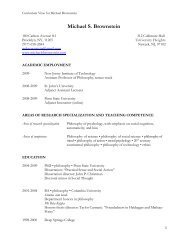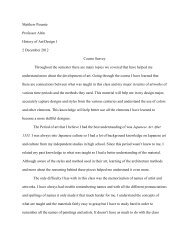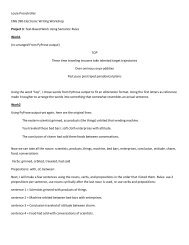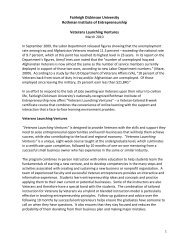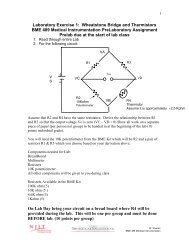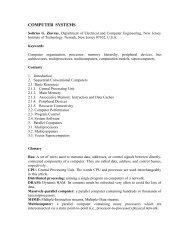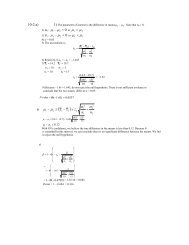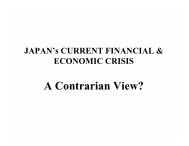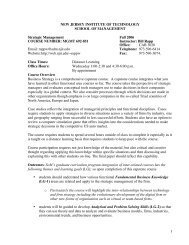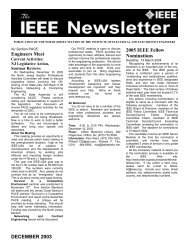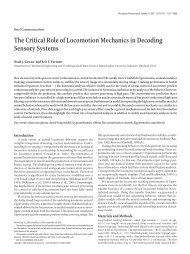2.5 Gbit/s duobinary signalling with narrow bandwidth ... - IEEE Xplore
2.5 Gbit/s duobinary signalling with narrow bandwidth ... - IEEE Xplore
2.5 Gbit/s duobinary signalling with narrow bandwidth ... - IEEE Xplore
Create successful ePaper yourself
Turn your PDF publications into a flip-book with our unique Google optimized e-Paper software.
<strong>2.5</strong> <strong>Gbit</strong>/s <strong>duobinary</strong> <strong>signalling</strong> <strong>with</strong> <strong>narrow</strong><br />
<strong>bandwidth</strong> 0.625 terahertz source<br />
L. Moeller, J. Federici and K. Su<br />
Following the field’s general trend to enhance system transport capacity<br />
by increasing the formats’ carrier frequencies and payloads, a novel<br />
approach is reported for <strong>2.5</strong> <strong>Gbit</strong>/s <strong>signalling</strong> at a carrier frequency<br />
of 625 GHz. Duobinary baseband modulation on the transmitter side<br />
generates a signal <strong>with</strong> a sufficiently <strong>narrow</strong> spectral <strong>bandwidth</strong> to<br />
pass an upconverting frequency multiplier chain. Power, bit error<br />
rate, and signal-to-noise ratio measurements on the receiver side<br />
describe the signal performance.<br />
Introduction: The advantages of terahertz (THz) communications<br />
have been recognised over recent years by the research community<br />
and a trend in THz <strong>signalling</strong> to increase carrier frequency, pay<br />
load, and transmission distance is noticeable [1, 2]. The rapidly<br />
growing interest can be attributed mainly to three intrinsic advantages<br />
which THz communications possess compared to its rivals at shorter<br />
infrared (IR) wavelengths and at longer wavelengths (millimetre<br />
(mm) wave). For example, T-rays (around 250 GHz) show several<br />
orders of magnitude smaller attenuation in fog at a visibility of a<br />
few hundred metres compared to IR light. Also, scintillation effects<br />
caused by local refraction index changes limit the reach of the IR<br />
beam [3, 4] based systems but exhibit less impairment to T-ray<br />
propagation. Furthermore, the useable <strong>bandwidth</strong> of T-rays at a<br />
same modulation index is higher than of mm-waves. These advantages<br />
become accessible when T-rays reside in the 200–300 GHz<br />
band and in the 600–700 GHz band where atmospheric absorption<br />
is relatively small.<br />
Several approaches for THz communications have been published<br />
[1, 2] showing progress in device design towards higher modulation<br />
rates. However, to simultaneously obtain high output power and large<br />
transmitter <strong>bandwidth</strong> at high carrier frequency remains in general challenging.<br />
Often THz sources are operating in resonance to efficiently generate<br />
output power which reduces their effective <strong>bandwidth</strong> to a few<br />
hundreds of megahertz.<br />
Our approach takes advantage of a format similar to <strong>duobinary</strong><br />
modulation – a technique known from wire line and optical communications<br />
[5, 6] that leads to a <strong>narrow</strong> signal spectrum – which<br />
our frequency multiplier chain based THz source can support. On<br />
the receiver side, a Schottky diode operated in direct detection<br />
mode, converts the THz signal into baseband. We envision one<br />
application of our setup in studying and comparing propagation features<br />
of THz links <strong>with</strong> those of IR links under different weather<br />
conditions.<br />
Modulation technique: Our commercially available 1 mW (CW operation)<br />
source consists of four cascaded frequency doublers followed<br />
by a frequency tripler, all based on biased Schottky diodes, which<br />
feed a horn antenna <strong>with</strong> a 2.4 mm aperture (Fig. 1). A launched tone<br />
<strong>with</strong>in the frequency acceptance band between 12.2 and 13.6 GHz saturates<br />
the 2 W input amplifier at about 5 dBm and gets upconverted<br />
into a frequency band between 585 and 653 GHz.<br />
Two identical THz lenses <strong>with</strong> short focal lengths (≏32 mm) allow<br />
source beam transmissions over distances of a few metres (beam<br />
diameter ≏ 20 mm) followed by refocusing of the beam on the receiver<br />
side into a horn antenna that is identical to the one used in the transmitter.<br />
The receiver horn is connected to a zero biased Schottky diode,<br />
which functions in the low power regime (input power ,10 mW) as a<br />
square law detector <strong>with</strong> large baseband <strong>bandwidth</strong> and a responsivity<br />
of about 2500 V/W. We characterise the ‘power transfer function’ of<br />
our system by sweeping the input frequency of the THz source across<br />
its acceptance band and record the output voltage of the Schottky<br />
diode in the receiver. Fig. 2a indicates a passband that is impaired by<br />
a ≏4 dB dip and 1 dB ripples. These ripples cause group delay variations<br />
across the filter passband and amplitude fluctuations, which<br />
together <strong>with</strong> the limited <strong>bandwidth</strong> make this source less suitable for<br />
signal modulation <strong>with</strong> a comparable wide spectrum (e.g. direct<br />
<strong>2.5</strong> <strong>Gbit</strong>/s non-return-to-zero (NRZ)). The spectrum of the signal indicates<br />
in Fig. 2a the optimal frequency position of the carrier at<br />
12.933 GHz (corresponding to T-rays frequency at ≏625 GHz) where<br />
the best system performance is achieved.<br />
PPG<br />
<strong>2.5</strong> <strong>Gbit</strong>/s<br />
ELECTRONICS LETTERS 21st July 2011 Vol. 47 No. 15<br />
V pp , a.u.<br />
700<br />
600<br />
500<br />
400<br />
300<br />
200<br />
100<br />
frequency<br />
synthesiser<br />
13 GHz<br />
T<br />
0<br />
–150 –100 –50 0 50 100 150<br />
DC voltage at IF port, mV<br />
bal.<br />
mixer<br />
LPF_1<br />
x 2 x 2 x 2<br />
x 2<br />
x 2 x 2<br />
frequency multiplier chain<br />
THz source<br />
LPF_2<br />
lens<br />
625 GHz<br />
clk scope<br />
BERT<br />
iris<br />
RF power<br />
ESA<br />
Fig. 1 Schematic of THz transmission link and balanced mixer<br />
characteristics<br />
5 dB/div.<br />
input<br />
THz source<br />
power<br />
transfer fcn<br />
10 11 12 13 14 15 16<br />
frequency, GHz<br />
a<br />
b c<br />
Fig. 2 Power transfer function (fcn) of system and spectrum of data signal at<br />
THz source input (Fig. 2a). Eye diagrams at 100 ps /div. after lowpass filter<br />
LPF1 (Fig. 2b) and (Fig. 2c) at THz source input (carrier at 1<strong>2.5</strong> GHz)<br />
Pre-coding the data reduces signal <strong>bandwidth</strong> but keeps its payload<br />
the same. Thus, the aforementioned filter impairments affect signal performance<br />
less strongly. Our pulse pattern generator (PPG) produces a<br />
<strong>2.5</strong> <strong>Gbit</strong>/s NRZ signal that gets split into two branches using a wideband<br />
6 dB electrical power splitter. One version is delayed by the<br />
duration of a bit (400 ps) before both replicas are combined using<br />
another wideband 6 dB power splitter. The resulting signal possesses<br />
three amplitude levels (21, 0, 1) and an advantageous phase coding,<br />
which significantly shrinks its <strong>bandwidth</strong> compared to its corresponding<br />
NRZ format. A following quasi Gaussian lowpass filter (LPF_1) <strong>with</strong><br />
about 1700 MHz 3 dB <strong>bandwidth</strong> reduces further the signal spectrum,<br />
mainly by cutting off its tail (Fig. 2b), which drives as baseband<br />
signal a balanced mixer to imprint its data on a carrier at a frequency<br />
accordingly to the acceptance band of the THz source. It is a specific<br />
feature of the balanced mixer that negative amplitudes of the driving<br />
signal result in a 1808 phase shift of the carrier. A high-speed scope<br />
can conveniently be triggered to visualise the output of the balanced<br />
mixer as an eye diagram when the product of the carrier frequency<br />
and bit duration equals an integer. Therefore, we choose for the eye<br />
recording a 1<strong>2.5</strong> GHz carrier frequency, which is close to our operation<br />
frequency of 12.933 GHz, where the system best performs (Fig. 2c). For<br />
DC-voltages in the range of the voltage swing of the launched data<br />
signal and applied to the intermediate frequency (IF) port of the mixer<br />
we record the amplitude swing of the output signal when a<br />
12.933 GHz tone is connected to the local oscillator port of the mixer.<br />
A small offset for applied DC-voltage between 25 and +5 mV is<br />
visible (Fig. 1) and could explain the unproportional widening of the<br />
‘0’ level at the mixer output (Fig. 2c).<br />
The spectrum of the data signal at the THz source input (Fig. 2a) for<br />
the carrier frequency that gives the best system performance resides at a<br />
position <strong>with</strong>in the passband of our system which exhibits relatively<br />
small filterband tilt and ripples. It has to be further investigated if our<br />
source and detector system can support even wider signal spectra by<br />
using different modulation formats and perhaps by including signal<br />
equalisation techniques<br />
Detection technique: On the receiver side the output of the Schottky<br />
diode is amplified by about 42 dB using two amplifiers (80 kHz–
7 GHz passband, 6 dB noise figure, maximum output power ≏19 dBm)<br />
and filtered by a quasi Gaussian lowpass filter (LPF_2) <strong>with</strong> 3 GHz<br />
3 dB <strong>bandwidth</strong>. A 6 dB electrical power splitter launches one output<br />
(Vpp ≏ 500 mV) to a high-speed scope or a bit error rate tester<br />
(BERT) and the other to a <strong>2.5</strong> <strong>Gbit</strong>/s NRZ clock recovery circuit that synchronises<br />
our measurement equipment.<br />
We emulate transmission losses by reducing the detected T-ray power<br />
<strong>with</strong> an iris inserted concentrically into the THz beam to limit its effective<br />
diameter (Fig. 1). The total receiver output power is measured <strong>with</strong><br />
an RF power meter while we record the corresponding bit error rate<br />
(BER) <strong>with</strong> and <strong>with</strong>out threshold optimisation (Fig. 3). After optimising<br />
the data decision threshold at a BER of about 1 × 10 23 (BER level<br />
that can be reduced to ≏1 × 10 215 by forward error correction coding<br />
<strong>with</strong> 7% overhead used in lightwave transmission systems [7]) increasing<br />
of the detected THz power leads to smaller BER up to <strong>2.5</strong> × 10 27<br />
where further power enhancement does not reduce the error count<br />
(error floor) for long (2 31 2 1) pseudorandom bit sequences (PRBS).<br />
In the case of threshold adjustment error-free operation is achieved at<br />
power levels above 214 dBm at the same pattern length. We investigated<br />
the impact of PRBS length by performing similar BER measurements<br />
<strong>with</strong> shorter patterns. For this we directly triggered the data<br />
decision <strong>with</strong> the pulse pattern generator (PPG) clock in order to<br />
avoid artifacts caused by the clock recovery when driven <strong>with</strong> long<br />
PRBSs. The short PRBS does not show error floors as exemplified<br />
<strong>with</strong> a 2 7 2 1 pattern in both cases <strong>with</strong> and <strong>with</strong>out decision threshold<br />
adjustment. Reasons for this could be the saturation effects of the receiver<br />
Schottky diode and <strong>bandwidth</strong> limitations of the receiver amplifiers.<br />
The clock recovery did not further degrade system performance.<br />
log (BER)<br />
3<br />
4<br />
5<br />
6<br />
7<br />
8<br />
9<br />
10<br />
11<br />
2 31 –1 fixed threshold<br />
2 31 –1 threshold optimised<br />
2 7 –1 fixed threshold<br />
2 7 –1 threshold optimised<br />
35 mV/div.<br />
100 ps/div.<br />
–22 –20 –18 –16 –14 –12 –10 –8 –6<br />
RF power at decision gate, dBm<br />
Fig. 3 BER curves for long and short PRBSs <strong>with</strong> and <strong>with</strong>out decision<br />
threshold optimisation<br />
Eye diagram at BER ¼ 10 29 at decision gate input for 2 31 2 1 PRBS<br />
Our current detector design based on commercially available Schottky<br />
diodes is suboptimal for high-speed <strong>signalling</strong>. The video resistance of<br />
the diodes, under low input power, is nominally ≏1.5 k.V and connected<br />
via a series of 50 V transmission lines and cables to an external<br />
high-speed electrical amplifier <strong>with</strong> matched input impedance [8]. For<br />
low-speed applications and after replacing the amplifier <strong>with</strong> a high<br />
impedance device about 270 mV at the Schottky diode output is detectable.<br />
But <strong>with</strong> 50 V termination of the diode significantly smaller<br />
voltage is accessible at the high-speed amplifier input. A rough estimate<br />
(applying voltage divider rule 50/1550) shows thus only about 3% of<br />
the signal voltage generated in the Schottky diode is applied to the<br />
amplifier input. We use this estimate to determine the operation<br />
regime of the diode. At the amplifier output RF powers of about<br />
214 dBm for a BER around 10 29 are typical. Assuming an amplifier<br />
gain of about 42 dB, the aforementioned voltage conversion factor of<br />
the diode, and a diode responsivity of 2500 V/W, yields an effective<br />
launched THz power of about 20 mW. This is significantly more than<br />
the vendor specs for the linear operation range of the device.<br />
To determine the signal-to-noise ratio (SNR) we modulated <strong>with</strong> a<br />
short and periodically repeated PRBS (2 7 2 1, 2 15 2 1) and measured<br />
<strong>with</strong> a high resolution electrical spectrum analyser the noise level at<br />
the receiver amplifier output. The noise level was found to be about<br />
18 dB above the intrinsic noise floor of the electrical spectrum analyser<br />
(ESA) and independent of the launched THz power. The total receiver<br />
noise was measured <strong>with</strong> an RF power meter to ≏ 2 36.4 dB. The<br />
obtained error rates are in fair agreement <strong>with</strong> the theoretical amounts<br />
expected for bipolar coding if vertical eye closure as visible in Fig. 3<br />
is accounted for in the calculation. The internal preamp of the used<br />
1<strong>2.5</strong> <strong>Gbit</strong>/s BERT does not significantly add noise to the data signal.<br />
Conclusion: We have demonstrated <strong>2.5</strong> <strong>Gbit</strong>/s error-free <strong>signalling</strong> at<br />
625 GHz carrier frequency over lab distance. BER curves as a function<br />
of measured receiver power are discussed. Our setup has the advantages<br />
of combining high output power on the emitter side <strong>with</strong> a comparable<br />
less complex receiver architecture.<br />
# The Institution of Engineering and Technology 2011<br />
17 May 2011<br />
doi: 10.1049/el.2011.1451<br />
One or more of the Figures in this Letter are available in colour online.<br />
L. Moeller (Bell Laboratories/Alcatel-Lucent, 791 Holmdel-Keyport<br />
Rd, Holmdel, NJ 07733, USA)<br />
E-mail: lothar.moeller@alcatel-lucent.com<br />
J. Federici and K. Su (New Jersey Institute of Technology, 323 King<br />
Boulevard, Newark, NJ 07102, USA)<br />
References<br />
1 Federici, J., and Moeller, L.: ‘Review of terahertz and subterahertz<br />
wireless communications’, J. Appl. Phys., 2010, 107, p. 111101<br />
2 Kleine-Ostmann, T., and Nagatsuma, T.: ‘A review on terahertz<br />
communications research’, J. Infrared Millim. Terahertz Waves, 2011,<br />
32, (2), p. 143<br />
3 Andrews, L.C., and Phillips, R.L.: ‘Laser beam propagation through<br />
random media’ (SPIE Press 1998), (ISBN 0-8194-2787-X)<br />
4 Andrews, L.C., Phillips, R.L., and Hopen, C.Y.: ‘Laser beam scintillation<br />
<strong>with</strong> applications’ (SPIE Press 2001), (ISBN 0-8194-4103-1)<br />
5 Lender, A.: ‘The <strong>duobinary</strong> technique for high-speed data transmission’,<br />
<strong>IEEE</strong> Trans. Commun. Electron., 1963, 82, pp. 214–218<br />
6 Penninckx, D., Chbat, M., Pierre, L., and Thiery, J.-P.: ‘The phaseshaped<br />
binary transmission (PSBT): a new technique to transmit far<br />
beyond the chromatic dispersion limit’, <strong>IEEE</strong> Photonics Technol. Lett.,<br />
1997, 9, (2), pp. 259–261<br />
7 Mizuochi, T.: ‘Recent progress in forward error correction and its<br />
interplay <strong>with</strong> transmission impairments’, <strong>IEEE</strong> J. Sel. Top. Quantum<br />
Electron., 2006, 12, (4), pp. 544–54<br />
8 Crowe, T.W., Porterfield, D.W., Hesler, J.L., and Bishop, W.L.:<br />
‘Submillimeter-wave and terahertz diodes, components and<br />
subsystems’. Joint 31st Int. Conf. on Infrared Millimeter Waves and<br />
14th Int. Conf. on Terahertz Electronics, Shanghai, China, 2006, p. 396<br />
ELECTRONICS LETTERS 21st July 2011 Vol. 47 No. 15



